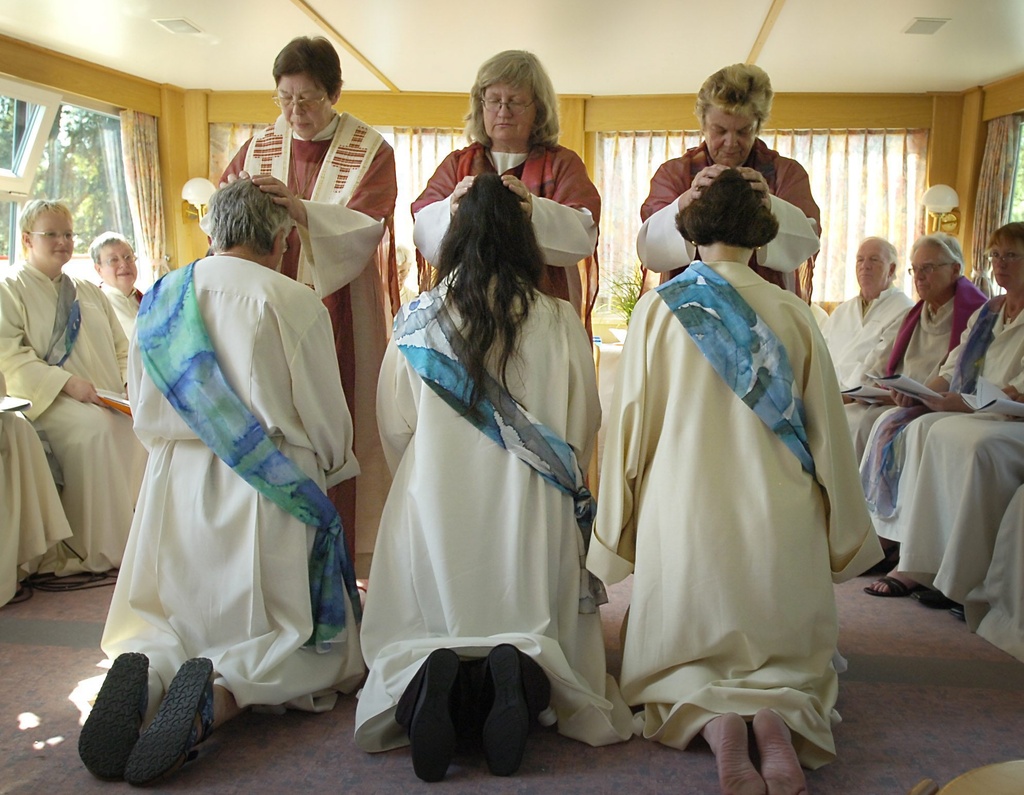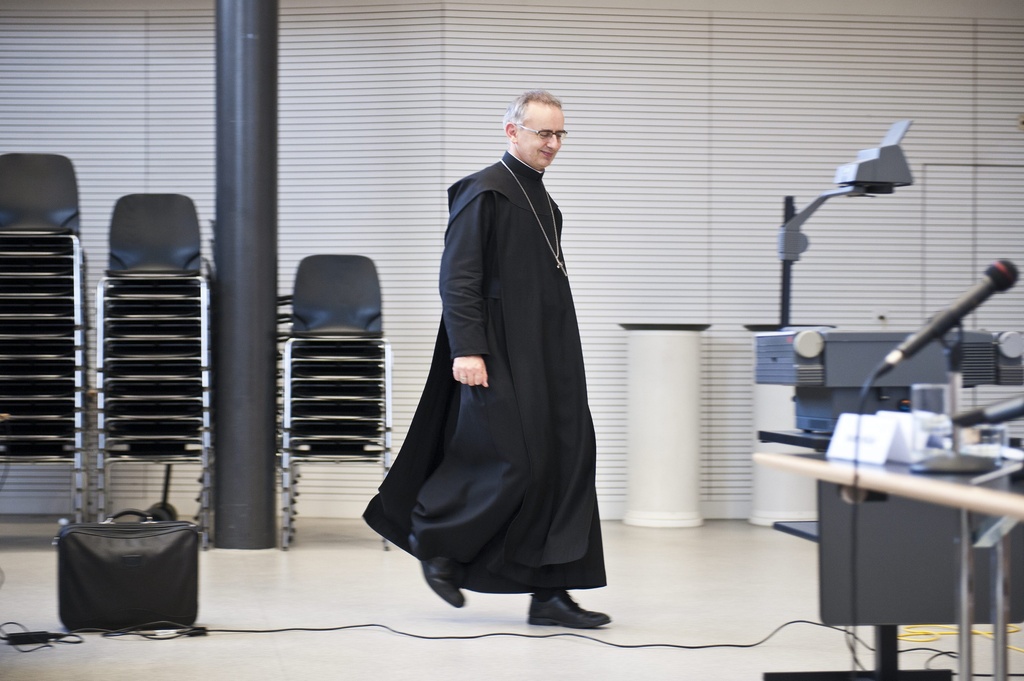Church looks to a future with fewer priests

A light-filled chapel forms the heart of the seminary in Villars-sur-Glâne near Fribourg. Built 30 years ago to hold 40 young men, it currently houses five.
It’s the same story at most of the country’s centres for training Roman Catholic priests. Researchers predict that in 2029 there will be one third fewer priests than there were in 2009.
They and progressive voices in the Church are calling for an open and honest discussion of its future.
In Basel, Catholics have even urged the dropping of the celibacy requirement* and demanded that women be admitted as priests. (See sidebar)
A book published by the Swiss Pastoral Sociological Institute at the end of 2011 uses current trends to chart the priesthood’s likely development. It predicts an ageing and diminished body of priests offset to some extent by an increased role for non-ordained workers.
“We made a prognosis about the next 20 years. And there’s no big surprise: the numbers of priests nearly everywhere will decrease,” co-author Arnd Bunker told swissinfo.ch. The institute director explains that the expected decrease is down to more priests dying than being ordained.
“This is an old problem, to do with vocations. Celibacy is a reason but it’s not decisive,” he said.
“It’s a problem of the place of the Church in the life of our society and culture. The place of institutionalised religion, the mainstream churches, has changed a lot. The old structures of vocation do not exist anymore.”
Vocations
Whereas in 1991, 177 students were in training for the priesthood in Switzerland, 20 years later that figure had dropped to 88. Looking into their crystal ball, the researchers believe that at best the number of vocations will remain stable. Unknown factors include possible changes to admission requirements and the longer term effects of the sexual abuse revelations in the Church.
At the seminary in Villars, Rector Nicolas Glasson is hopeful that the decline in ordinations will halt or even be reversed, as seems to be the case in neighbouring France.
“In France in the past 30-40 years they have gone through what we’re going through now. In the past two years numbers have been static there and now they are up about ten per cent,” Glasson told swissinfo.ch.
In April-May 2010 the Church in France launched a public relations campaign aimed at attracting more young men to the priesthood. Tens of thousands of postcards were distributed in cafés, cinemas and college campuses and a facebook forum dealt with enquirers’ questions. The Church pronounced it a success.
Seminarians Mikhaël Boichat, 22, and Francois Perroset, 29, are in the third and fourth years of study respectively. They see trends in society as being responsible for the fall in vocations. But they believe God is still calling young men to the priesthood. What is needed is the support of family and friends.
Current solutions
Bünker says views on what needs to be done differ, with the six bishoprics all pursuing their own strategies.
In terms of priest numbers, St Gallen has the biggest problem. (See graphic)
“On the other hand it has more or less the same number of lay pastoral workers as professionals. They are also the youngest in Switzerland. So one could say St Gallen is coping very well with the situation.”
Other dioceses, including Lugano, are resorting to recruiting priests from other countries. But this is not a long-term solution, in Bünker’s view.
“We have to reflect on whether a church is able to reproduce itself. Our local churches are not sustainable.” Bünker sees a fundamental problem with importing priests from countries where the ratio of Catholics to priests is higher than in Switzerland. (See graphic)
Then there are cultural and language issues. “There’s also a problem with racism and acceptance. It’s a problem for the priests coming from abroad and it’s also a challenge for the communities and parishes who have to find a way of living together,” said the researcher.
On the other hand, “importing” priests enriches the local Church’s diversity and brings different perspectives, he believes.
Winds of change
Next to St Gallen the diocese of Basel, which also includes Bern, has seen the biggest drop in parish priests in the past 20 years. A pastoral development plan (PEP) was set up five years ago to address the problem. Parishes are grouped together into two pastoral areas, with a priest in charge but lay workers often conducting worship services.
According to theologian Monika Hungerbühler, a pastoral worker in the Basel church, similar programmes are in place in Germany, and the idea is spreading in Switzerland.
“The thinking is about merging parishes, even across cantonal boundaries,” Hungerbühler told swissinfo.ch. “And deciding where there should be church services and where we should be doing social work.”
Nicolas Glasson believes a time is coming when church services will not be held in every village, but in pastoral centres serving wider communities.
“We want to baptise everyone, offer church funerals and weddings, but soon we won’t be able to do all that. We could create an organisation appropriate for the number of priests we have and not one along geographical lines.”
“We have the sense of going backwards, and as a not-so-old priest, I want to go forwards,” he said with a laugh.
Hungerbühler, who is behind an initiative submitted to the Basel synod in January which calls for women priests as well as an end to the celibacy rule, also wants to see the Church move with the times. She believes that 50 years after the Second Vatican Council that set reform in motion, it’s time for a third council.
“For me it’s important that more and more parishes and dioceses go to Rome and say we need a new council. We have to think about different solutions, for example, a synodal structure so that in different continents different leadership or pastoral structures are possible.”
“I hope very much that in 30 years there will be married priests here and that women will be able to become deacons and priests. That we’ll have a courageous bishop who will say we have suitable women as well as men for the priesthood.
“At present church law doesn’t allow that. But if there were a third Vatican council and a breath of fresh air was let in perhaps a way could be found.”
The church equality initiative (Kirchliche Gleichstellungsinitiative) was handed in to the Basel church authorities in January 2012, with 2,000 signatures of church members in cantons Basel city and Basel country.
The initiative calls on the synod and church council to work to introduce the priesthood of women and to ensure compulsory celibacy is done away with.
The synod is obliged to answer within two years.
Co-organiser of the initiative, Monika Hungerbühler, says a podium event with supporters and opponents of the initiative to exchange views is being mooted for the end of the year.
Allowing women to become priests is “a question of fairness”, according to Hungerbühler. “In Switzerland we were almost the last to introduce voting rights for women, although it’s said Switzerland is the world’s oldest democracy.”
“Many women already feel they are priests but aren’t allowed to be priests in practice,” she says.
In the Catholic Church women are allowed to do everything except dispense the seven sacraments: baptism, confirmation, holy communion, confession, marriage, holy orders, and the anointing of the sick.

In compliance with the JTI standards
More: SWI swissinfo.ch certified by the Journalism Trust Initiative




You can find an overview of ongoing debates with our journalists here. Please join us!
If you want to start a conversation about a topic raised in this article or want to report factual errors, email us at english@swissinfo.ch.